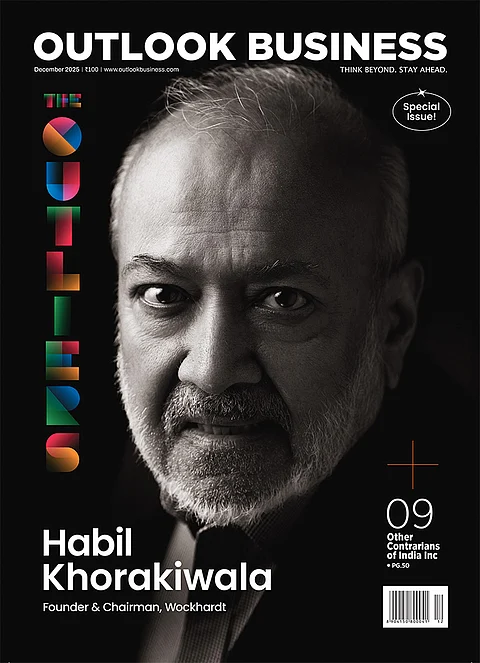In 2005, 24-year-old Ashish Kumar, now co-founder at the venture-capital (VC) firm Fundamentum, quit his job at Microsoft in the US to return to India and start his own venture. At the time, entrepreneurship was neither celebrated nor respected. Relatives fretted that he was throwing away hard-won achievements: an IIT degree, a coveted job and a promising career in the US.
About a decade-and-a-half later, things were beginning to change.
In 2019, Abhinav Singh, then a 25-year-old product designer in Bengaluru, faced a quiet heartbreak. His start-up, Colorpur, which allowed graphic designers to upload designs for product manufacturing, was shutting down. Although it wasn’t a spectacular failure, it simply didn’t scale the way he had envisioned. Yet, as he packed up his modest office, Singh felt something unexpected: optimism.
“It’s much more ‘cool’ now to be a founder,” he says. “Earlier, being a start-up founder was even seen as a red flag when getting married! But the key shift is that failure doesn’t define you anymore.”
Singh’s journey reflects a broader cultural shift in India’s entrepreneurial ecosystem. For a long time, failure carried a heavy stigma. Parents, peers and society at large saw it as a mark of irresponsibility.
Today, it is increasingly viewed as a rite of passage. For instance, it has become quite common for founders to publicly announce that they are wrapping a company and returning the money to investors when their ideas don’t scale. This would have been unthinkable in the past.
The changing perception is not just anecdotal; it is visible in the rising number of start-up founders announcing their closures because their idea didn’t pan out or scale.
The acceptability of failure as a learning experience has also been propelled by celebrated examples of founders like InMobi founder Naveen Tiwari’s whose first four start-ups failed before the fifth turned into India’s first unicorn.
Roughly 49% of unicorn founders in India are repeat founders. There is a surge in second-time founders who aren’t satisfied with their early successes. They throw their hats in the ring again, betting their reputation and money on new ideas.
Not only that, the country is witnessing a surge in second-time founders who aren’t satisfied with their early successes. They throw their hat in the ring again, betting their reputation and money on new ideas. Take for instance Kunal Shah who sold his fintech start-up Freecharge in a $400mn deal in 2015. A few years later he hit the entrepreneurial road again with fintech app Cred.
Similarly, after Flipkart cofounder Sachin Bansal became a billionaire on selling the company to Walmart, he started financial-services company Navi.
“We’ve seen 40-plus founders with prior success build new ventures and succeed again,” says Yagnesh Sanghrajka, founder and managing partner at 247VC, a VC firm.
Freeing Up Funding
Of course, easier access to capital and deeper internet penetration have made things easier. Today India has over five lakh start-ups, a monumental rise from roughly 500 in 2016. Annual funding for start-ups has gone up from $5.2bn in 2016 to $12.7bn in 2024, according to data from market-intelligence platform, Tracxn.
The deepening of capital didn’t happen only at the early and growth stages when money is raised privately. In time, the government also unlocked the public market to mature start-ups, which helped retail investors in the stock market and institutions like mutual funds appreciate and participate in the ecosystem.
For decades, India’s capital markets viewed profit as the ultimate test of worth. The Securities and Exchange Board of India (Sebi) once barred loss-making firms from going public, reflecting a belief that retail investors prized dividends over growth narratives.

That changed in 2021, when Sebi amended its rules to allow new age technology companies without profits, but strong investor backing, to list on the exchanges. The blockbuster debut of Zomato that year marked a paradigm shift. Millions of first-time investors poured money into start-ups whose value lay in scale, data and ambition rather than profits.
Since then, more than a dozen such companies have listed, showing that regulators have kept pace with a changing economy and how retail investors have evolved from dividend-seekers to believers in innovation.
According to data platform TheKredible, over 100 start-ups have implemented Esop buyback, liquidity and payout programmes worth around $1.7bn from 2020 to 2025.
Employee stock ownership plans (Esops), which give employees an ownership stake in the company, have also played a significant role in normalising the idea of start-ups as an avenue of wealth creation. “People started hearing about employees who had become millionaires overnight because of Esops when their companies scaled or went public. Suddenly, working at a start-up didn’t seem risky anymore,” says Arun Nair, chief executive of reality show Start-Up Singam.
According to data platform TheKredible, over 100 start-ups have implemented Esop buyback, liquidity and payout programmes worth around $1.7bn from 2020 to 2025.
Going Mainstream
As the idea of wealth creation through start-ups seeps into popular culture, TV shows are dramatising founder lives, authors are writing memoirs and filmmakers are turning start-up stories into films.
Reality shows like Shark Tank India have transformed the perception of entrepreneurship from abstract to relatable, inspiring millions across demographics. “When you see a 12-year-old pitching a bike idea or a 65-year-old woman selling organic products, it shows why business success in India can no longer be defined by age, city or degrees,” says Aman Gupta, co-founder of consumer-electronics brand boAt Lifestyle and judge on Shark Tank India.
In the last few years, comedians like Kapil Sharma have hosted episodes featuring entrepreneurs, blending humour with inspiration. When business leaders like NR Narayana Murthy and Vijay Shekhar Sharma appear on mainstream shows, making entrepreneurship visible.
Meanwhile, books such as Big Billion Startup: The Untold Flipkart Story and Doglapan have seen a surge in demand. Publishers say entrepreneurial narratives are in high demand, with books on start-ups selling two to three times more than the average non-fiction title.
Today, India has over five lakh start-ups, a monumental rise from roughly 500 in 2016. Annual funding has gone up from $5.2bn in 2016 to $12.7bn in 2024.
“The moment the Flipkart book hit the market, demand was immediate, it didn’t have to be pushed. The author [journalist Mihir Dalal] had covered Flipkart for years as a journalist. I pitched the book to producers as India’s edition of The Social Network and that pitch clicked. In fact, I sold the screen rights even before the book was published, that was in 2020,” says Anish Chandy, founder of Labyrinth Literary Agency, the literary agent for the book.
This has normalised not only the decision to start a company but also work in start-ups, giving social acceptance to such career risks. And as this narrative changes, mid-career professionals with established corporate backgrounds are making deliberate moves into start-ups.
Sameer Dhanrajani, chief executive of AI consulting and advisory firms AIQRATE and 3AI, underscores the experiential advantage mid-career founders bring. “Corporate life gives you title, pay, travel and comfort. Start-ups are the opposite: you’re in the grind, doing many roles, from janitorial to CEO. But the internal call came: if I didn’t try now, I might never,” he says.
For large tech companies, it has become a matter of pride to talk about their ‘Mafia’—former employees who went on to launch successful companies. This concept first gained ground in the US with the ‘PayPal Mafia’, referring to the early PayPal employees who went on to found major tech companies such as Tesla, LinkedIn and YouTube.
Similarly, India is now witnessing the rise of the ‘Flipkart Mafia’, ‘Zoho Mafia’ and ‘Zomato Mafia’.
Demographic Dividend
Exams are the last thing on 16-year-old Adithyan T’s mind. The Class 11 student in Bengaluru pulls out his phone to demonstrate the prototype of an app he is building, a peer-to-peer platform for students to exchange textbooks.
He speaks with the fluency of a founder, casually dropping terms like “user acquisition” and “early traction”, picked up from binge-watching Shark Tank India. “I watched it with my parents and thought, why not me,” he says. “Getting into IIT is about proving yourself to an exam. Starting up is about proving yourself to the world.”
Thirteen-year-old Rishaan Sindhwani, a Class 8 student, has already launched his own start-up, Optimize Site, a website-creation venture. “Today anybody can be an entrepreneur,” Trilok Sindhwani says, talking about his grandson’s start-up. “All you need is a hobby and [to] link it up from India to Ghana or America or Japan.”

Educators are leaning into this shift. Many schools now weave entrepreneurship into extracurricular activities and even formal curricula, with some tying up with incubators to mentor student projects.
Universities are also incubators of entrepreneurial ambition. IIT Madras and IIT Bombay are integrating start-up-focused coursework into their curricula. “Students are asked to think like VCs,” says Gopal Shukla, chief executive of IIT Bombay and Washington University. “Selected ideas are pitched to US investors, with some winning awards and funding.”
Government initiatives, too, play a key role. The Atal Innovation Mission has established thousands of tinkering labs, while TiE Young Entrepreneurs (TYE) and Young Entrepreneurs Academy (YEA) give high-schoolers hands-on experience building and pitching ventures.
Meanwhile, entrepreneurs in Tier-II and -III cities are increasingly seizing opportunities, overcoming infrastructure gaps and attracting attention from VCs.
“Back in 2003, starting a business felt alien. My mother couldn’t sleep for a week when I took an office on rent. Today, there’s far more awareness, mentorship and access to capital,” says Sarthak Aggarwal, founder of Theater Apparel, a fashion start-up.
Griffith David, founder and chief executive at Habanero Foods International, a food-products company and Amit Shah, founder of Offee, an ed-tech start-up, recall the initial scepticism from their families, particularly when leaving their jobs or moving back to India from abroad. Over time, this changed.
“I spent a long time doing corporate jobs in Silicon Valley, but around 2006–07, I began noticing big shifts in India. My parents were shocked when I left the US for India, but over time, they saw my passion and supported me,” says David.
“When the prime minister says, ‘You should start up, you should innovate’ everyone listens, including parents. That made it legitimate for them,” says Shah.
This validation made it easier for young founders to pursue ventures without constant pushback from family.
Yet the pace of change is uneven. Fundamentum’s Kumar adds, “In Tier-II and -III cities, the stigma still exists for potential partners’ families, but in Tier-I cities, entrepreneurship is better understood and respected.”
More to Build
Despite the growth and cultural embrace, structural challenges persist. Banks remain hesitant to lend to early-stage start-ups, demanding collateral that young ventures often cannot provide.
Their concern is the high risk of mortality associated with start-ups, which can result in loans going bad.
Meanwhile, deep-tech start-ups face a shortage of patient capital. Tracxn data shows that India’s deep-tech start-ups have raised $7.64bn in VC and private funding since 2015. This number for China is $72bn and $402bn for the US. As a result, many of India’s best minds migrate to the US for funding and market maturity.
“This limited investor appetite means deep-tech start-ups often operate with constrained capital from the outset. But deep-tech founders from our experience are far more efficient in squeezing the rupee than their peers in the execution-first spaces,” says Rahul Chandra, managing director of VC firm Arkam.
India has come a long way from a country where failure was taboo to one where entrepreneurship is dinner-table conversation. But to play the bigger game, it must expand its risk appetite by an order of magnitude. Only by betting on harder problems and accepting longer timelines can India graduate from being a start-up nation to a true product and innovation nation.
Yet, India’s trajectory so far is undeniable. As some in the ecosystem like to say: it is still day zero.













